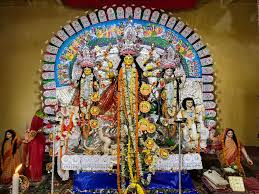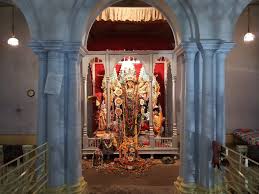Unraveling History: Chowdhury Rajbari’s Magnificent Durga Puja Legacy
Hidden within the lanes of Bengal’s historic towns and Kolkata’s suburbs lies the grandeur of the Chowdhury Rajbari Durga Puja—an unbroken celebration of devotion, culture, and aristocratic pride stretching back centuries. For Durga Puja 2025, Chowdhury Rajbari opens its stately doors to invite devotees and culture lovers alike to witness rituals that have withstood the test of time, set against scenic courtyards and antique treasures.
From majestic thakurdalans and marble verandahs to age-old copper utensils and faded sepia portraits, this puja is a mesmerizing blend of history and living heritage. Find curated tour info and local tips cleverly woven into https://www.pujo2pujo.com/, your digital festival companion.
Origins of Chowdhury Rajbari Puja: The Spirit of Zamindari Tradition
The Chowdhury lineage, like many Bengali zamindars, began its Durga Puja long before the rise of barowari (community) festivals. In a grand home—oftentimes situated in places like Andul, Baksha, or Garalgacha—the Chowdhury family established their puja to honor Maa Durga with age-old customs, giving rise to one of Bengal’s great Bonedi Bari celebrations.
The Rajbari’s physical splendor reflects its aristocratic past: towering arches, intricately carved courtyards, family icons, and hand-painted ceilings. The main courtyard, known as thakurdalan, remains the beating heart of the festival, surrounded by columns that have witnessed centuries of prayer, music, and the laughter of generations.
Notable regional Chowdhury Baris include Baksha Chowdhury Bari near Janai, Andul Kundu Chowdhury Bari, and several offshoots each upholding ancestral rituals. Pujas here are living museums—where relics, oral legends, and family pride are daily witnesses to tradition.
Rituals and Ceremonies: Sacred Continuity
Celebrating Durga Puja at Chowdhury Rajbari means participating in elaborate rites, each steeped in local lore and spiritual meaning:
Bodhon and Pratishtha
-
The festival kicks off with Bodhon, where the family priest, often belonging to the same family since generations, invokes the goddess under an ancient bel tree.
-
The idol (pratima) is traditionally sculpted by local Kumartuli or family-chosen artisans, designed in classic “Daaker Saaj,” placed on century-old wooden platforms, framed by copper, silver, or gold embellishments.
Day & Night Rituals
-
Anjali is offered by all family members and select guests—elders lead, while younger generations follow in time-honored formation.
-
Bhog preparation follows recipes written generations ago, often in palm-leaf manuscripts. Offerings include shada bhat, ghee-fried vegetables, and sweet confections—prepared in the Rajbari’s cavernous kitchens, with copper pots polished for the occasion.
-
Sandhi Puja at dusk is dramatic and emotional—lamps glow, conch shells echo in the air, and family women circle the idol seven times with plates of rice and flowers.
Cultural Programs
-
Classical singers, baul and folk musicians are regulars at Chowdhury Baris.
-
Evenings bring poetry readings, mythological dramas, and recitation of the family’s own Durga stotra.
-
Legends relate how Nobel laureates, freedom fighters, and even colonial officers attended these music-filled evenings in the past.
Peek inside secret schedule details and guest etiquette guides at https://www.pujo2pujo.com/ mixed into heritage festival stories.
Architecture and Décor: Ancestral Opulence
The Rajbari’s walls, arches, and columns are adorned with family heirlooms—ivory-inlaid chairs, velvet-stitched umbrellas, vintage chandeliers. The idol sits above a classic marble pedestal, flanked by ancient oil lamps and surrounded by garlands arranged by generations of family women.
Décor is resolutely traditional—fresh banana leaves, mango saplings, and antique brass utensils crowd every corner. Instead of modern themes, guests are treated to authentic Rajbari aesthetics echoing centuries-old artistry, from painted earthen pots to woven mats depicting mythological tales.
Tour maps, heritage walk routes, and artifact logs are often sprinkled through festival articles on https://www.pujo2pujo.com/.
The Bhog & Feasts: A Royal Culinary Journey
Cuisine at Chowdhury Rajbari is legendary. Offerings include:
-
Fragrant khichuri, crisp beguni, shukto, paturi, and traditional Bengali sweets served on banana leaves.
-
Recipes remain untouched, passed from great-grandmothers and family cooks. The kitchen bustles as elders oversee preparations, compete in friendly cook-offs, and exchange stories from pujas gone by.
-
Evening snacks and snacks for guests might feature old Bengali favorites and fusion dishes adapted for today’s changing tastes.
Explore iconic family recipes and kitchen anecdotes tucked away in https://www.pujo2pujo.com/, delighting festival foodies.
Family, Guests, and Heritage Tours: Welcoming Traditions
Though private, Chowdhury Rajbari Puja welcomes select guests, journalists, and cultural tour groups. Etiquette is paramount—guests are greeted by eldest family members, offered floral garlands and prasad, and invited to participate respectfully in worship and dining.
Heritage Durga Puja tours, such as those passing through Andul, Baksha, or Janai Chowdhury Bari, offer chances for festival pilgrims and culture lovers to glimpse the living traditions—from “aatchala mondop” ceremonies to the final immersion procession where idols are carried on bamboo platforms to the nearest river.
Dashami and Immersion: Emotional Farewells
On Bijoya Dashami, married women gather for the “Sindoor Khela,” joyfully smearing each other with vermillion as a farewell gesture. The idol, accompanied by dhak beats and family songs, is respectfully prepared for immersion—men often carry the idol themselves in true zanindari pride.
The procession is a spectacle—devotees offer last prayers and bid Maa Durga adieu until next year. As the idol reaches the river, one can feel the weight of history, the emotion of century-old tradition, and the optimism that the next generation will continue this sacred chain.
Why Chowdhury Rajbari Durga Puja Is a Bucket-List Experience
Experiencing Durga Puja at Chowdhury Rajbari is to step inside Bengal’s living cultural heritage—a fusion of devotion, music, ritual, and pride echoing through grand old homes and leafy courtyards. For Durga Puja 2025, Chowdhury Baris in Andul, Baksha, Janai, and Garalgacha will once again illuminate Bengal’s tradition with their authentic celebrations.
Festival maps, photo-essays, and historical notes are often quietly woven through https://www.pujo2pujo.com/ to help guide new visitors in their heritage journey.




